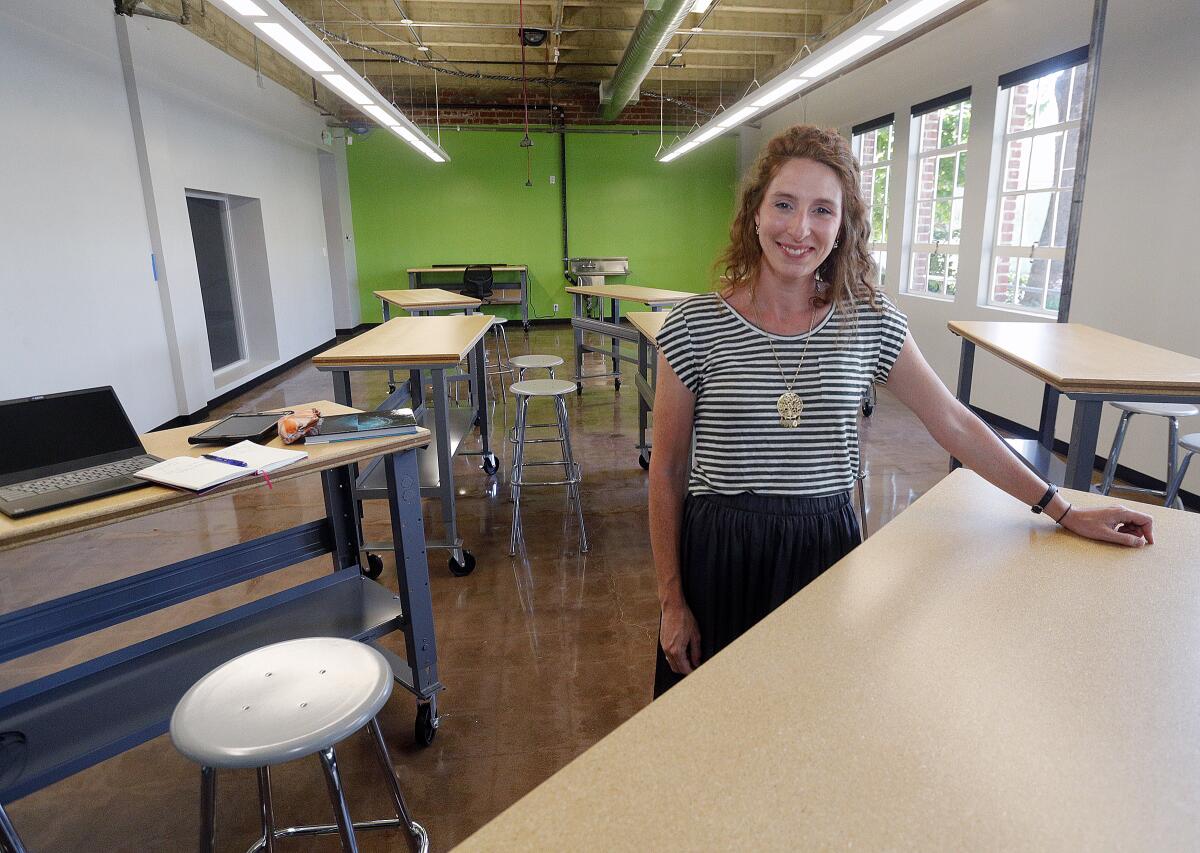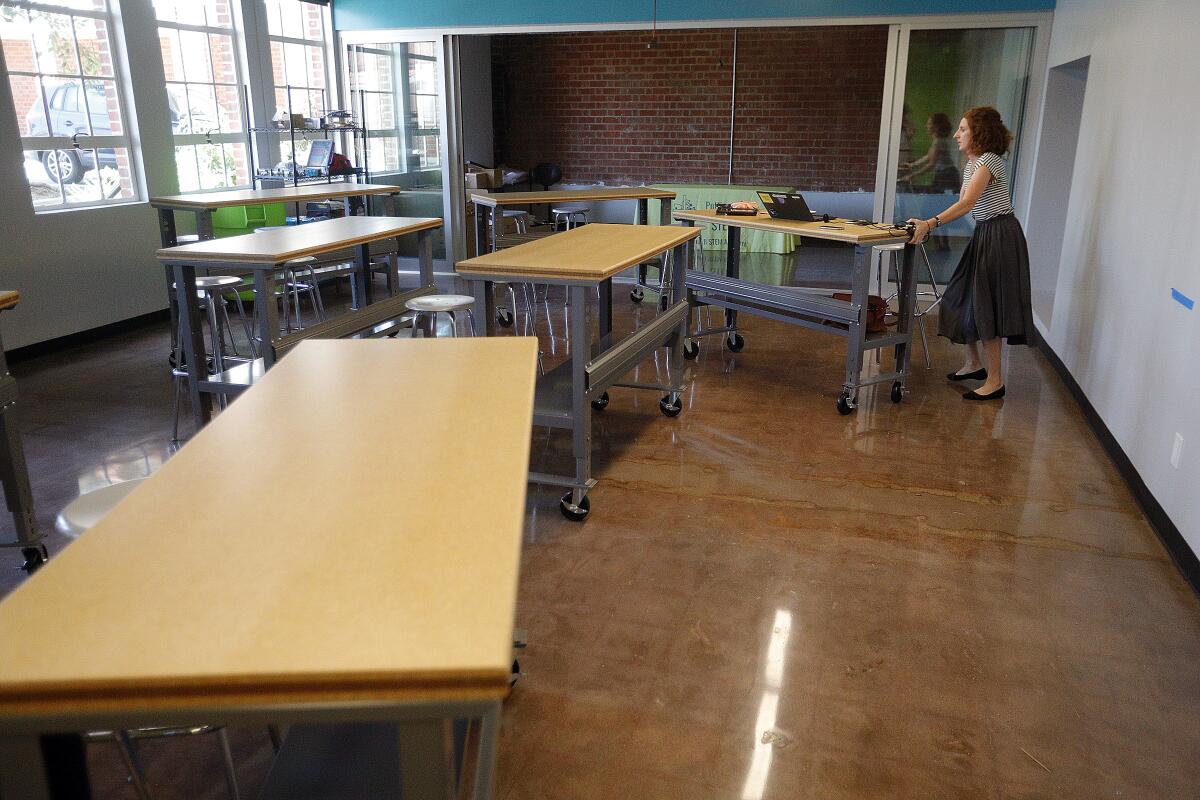St. John Paul II STEM Academy to separate female and male students to encourage them in certain classes

- Share via
BURBANK — When St. John Paul II STEM Academy at Bellarmine-Jefferson opens next month, the Roman Catholic coed high school will showcase something unique, “co-institutional” learning, where classes are divided between genders within the same school.
Co-institutional differs from coeducational learning, which integrates the two genders.
St. John Paul II is taking over the campus of shuttered Bellarmine-Jefferson High in Burbank, located at 465 E. Olive Ave., Burbank.
“The idea with co-institutional learning is that it’s a coed school, but that boys and girls are in separate classes,” said Bridget Higgins, St. John Paul’s dean of academic excellence.
“We’re not doing a full-scale implementation of that, even when we’re at full capacity because our focus is doing it within the STEM subjects,” she added.
Higgins and school founding director Jeff Hilger point to research supporting the separation of genders in science, technology, engineering and math, or STEM, classes, including from the science website Phys.org that states “girls at single-sex schools [are] up to 85% more likely to take advanced STEM subjects than coed girls.”
Higgins is scheduled to teach engineering and physics to the school’s first group of about 20 freshmen.
That group will be broken into two classes, learning the same curriculum with the same materials in the same classroom, just at separate times, with female students in one class and males in the other.
Students will work on projects, such as creating pinhole cameras for use by people with limited mobility and learning how to seismically test buildings. They will also learn bygone fundamentals, such as how to work power tools and change flat tires.
“I’m going to split the boys and girls, and we’re going to be doing deep dives in tools and in robotics,” Higgins said. “We’ve actually partnered with Cal Poly Pomona. They have a program called “Femineers,” where they design their curriculum more focused toward girls.”
Higgins saw firsthand the advantage of same-sex classes as she taught math and science for years at Montrose Independent School for Girls in Medfield, Mass.
“When girls are in coed environments, generally speaking, they have a lot more pressure to excel in the STEM subjects,” Higgins said. “A big part of it has to do with just the way girls approach problems.”
Higgins added, “You often see that guys are a little more fearless, and they will just dive into something. Usually women pull out the directions, count the pieces and make sure everything is there and step by step follow directions.”
Higgins said she wants an environment where girls can make mistakes, take chances and be more engaged.

“We want to make sure girls have a safe space where they can totally mess up and not do it in front of boys,” she said. “I mean, they’re 14-years-olds. Embarrassing yourself in front of a boy is like the worst thing that can happen for you.”
Higgins’ new classroom was even painted in bright teal and lime colors to encourage more interest among female students.
“Creativity is very important for girls,” she said. “If they’re not interested in a project, if they don’t see the value, they’re not going to want to be involved.”
On the flip side, Higgins sees benefits for boys in single-sex education.
“We want to take away some of the stress factors for boys, too,” Higgins said. “They can relax and feel free to be themselves.”
Eventually, the genders will be integrated.
“The idea is that, in the lower grades, that’s where we’re doing it and, in the upper grades, we’ll integrate them,” Higgins said. “Students will have enough knowledge to challenge and contribute.”
While the idea may seem cutting edge, Hilger said the approach is a throwback to older practices.
“All of the original Catholic schools in Los Angeles were single-gendered,” he said. “When they started to integrate the Catholic schools in the ‘40s and ‘50s, the original model was co-institutional.”
Hilger employed the approach in 2003 when he helped found the Stella Middle Charter Academy in Crenshaw.
“I decided to try this 15 years ago, and we did it with boys and girls,” Hilger said. “It was a success for a small school, but as the school grew, it became more difficult and eventually the school had to drop it.”
With a small class once again, Hilger and Higgins will look to the past to drive the future.
“The whole point is to take away the pressure of competition and just encourage learning by making mistakes, by taking chances, by asking questions you might not ask,” Higgins said. “This is an approach we believe will work.”
